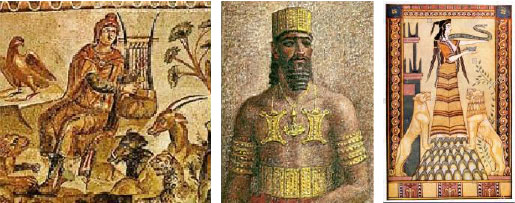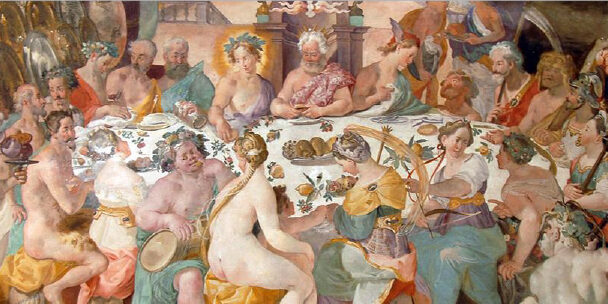In this first episode we will learn about the history of the Tartessian and Roman gastronomy of our city and Andalusia. Great treasure that houses this land. Slow-forged in pots over the centuries.
In the second installment we will relate Visigothic, Muslim, Jewish, medieval and Golden Age history to cooking.
We will also include some recipes from today and always! To encourage you to do them.
In addition, we will discover forgotten or unknown recipes, foods that have already disappeared, surprising social uses, table preparations in the family environment. After all, the features that define the nature of our cuisine, of what we eat today. Of what we are.
As they have left us an inheritance full of popular wisdom, such as the fact of using products according to seasons to prepare dishes suitable for each season.
To find out what and how our ancestors ate and take away that curiosity, we wrote these lines taken from the book “History of Andalusian Gastronomy” by Juan Antonio Molina We will make a fascinating trip full of spices and flavors.
The morphology, geographical singularity, climate and other aspects of Andalusia have clearly influenced Sevillian gastronomy; rocky to the east, coexisting with the saltpeter of the Mediterranean and the Atlantic, a link with other worlds, a stimulus rather than a barrier to invasions, caressed by snow, natural ports, to the north Sierra Morena, Sierra Bética, the Guadalquivir depression.
In short, what else can we say, a splendid place to live, cook and, best of all, eat.

The wheat was of great quality, furrowed by excellent oxen. Much appreciated and imported by Rome. April barley was the best in the known world. Crops were stored in deep silos.
When the Phoenicians arrive in Tartessos, they introduced olive oil, olive trees and olives. They were courageous sailors who made incursions by boat to the Canary Islands. They caught large octopuses and incredible fish, such as giant tuna, since they ate the acorns that reached the sea through the rivers. They ate a lot of tasty lamprey and a great variety of molluscs such as clams, cockles, razor shells and reeds.
At that time, you could admire the famous bulls, descendants of the mythical Gerión. Through his veins flowed the blood of the primitive aurochs.

In these commercial transfers, they hunted large gallinaceous birds such as the great bustard, mountain goats and, above all, rabbits. Since neither Greeks nor Phoenicians knew them. These were lands of these animals.
From the ancient tuna traps on the coasts, the famous brines, the “garum”, arrived in Seville. Usually made from tuna, rubble, or mackerel.
It was sold at very high prices and was exported in large quantities.
It was taken alone or diluted with water, softening its strong flavor. Other times it was flavored with wine, oil and even vinegar.
The Greeks introduced the vine. There were many varieties of grapes, the most appreciated was the dry or sweet “balisca”. Highly valued in the upper Sevillian social classes.
Vine grapes are also cultivated.
Many times certain substances were added, such as sea water, resins, herbs, even smoked with smoke.
Many types of fruit were eaten, but figs were a delight for Sevillians. There were factories that dried them in the sun, pressing them and packaging them in wooden or esparto boxes. Cherries were also considered a delicacy and were exported, red, black and green.
The “malum punca” or pomegranate was on the banks of the Guadalquivir, already imported by the Carthaginians.
The grafts they made were also well known; plum tree on apple tree feet creating the “molina”. Plum tree on almond feet, creating the tonsillar plum, whose bone was an authentic almond.
ROMAN CUISINE
During this period, the lands were cultivated with great care, the extensive trade of the Empire, the great development of roads and other public works placed the Baetica and “Hispalis” in an unbeatable place.
The great export of our oil was a fundamental pillar of the economy. The merchants were organized in private schools, until the third century, then it was a state matter.

Sevillian Romans ate a wide variety of foods:
Among the vegetables, the nettle was highly esteemed and was even cultivated. The mallows were eaten in a salad, the virgin vine, the dandelion, the navel of venus, the immortelle. Elecampane root was taken boiled to remedy gastric illnesses.
Vegetables such as cabbage were also part of their diet. The lettuces were preserved in brine or oxyhoney. The chard was cooked with mustard for flavor.
Thistles were a luxury vegetable in Sevillian markets. Its stems were candied and recipes have been found to season artichoke bottoms.
Carrots were disdained, but parsnips had as many consumers as turnips. Onions were indispensable in Sevillian Roman kitchens. Other bulbs were consumed such as gladiolus, hyacinth and asphodel, which was reputed to be an aphrodisiac.
Garlic was eaten, but it was not to everyone’s taste, many considered it poisonous. Sometimes they used excessive amounts of herbs in the stews, such as coriander, coriander, parsley, celery, flavored with selfion, crushed mustard.
The melons that we consume today would have surprised the Romans, before they were the size of an orange.
Cucumber, for example, was the favorite vegetable of Emperor Tiberius.
Legumes were highly prized, his favourites, the small black Egyptian lentils.
Deserters had their right hands cut off and their ranch consisted of bread and vegetables.
Peas and grains of peas were consumed. Chickpeas being very popular in the Sevillian lower classes.
Broad beans were already known and were an important part of some religious ceremonies, for example, to elect the king of the party at Saturnalia (a mix between Christmas and current carnival.
Olives were prepared in many different ways and with different dressings or brines. They were very fond of mushrooms: agaricos, boletes, lactarios, russulas, etc. The most desired was the “caesarean fly agaric” different from the “fly agaric muscaria”, very toxic. Highly demanded were the truffles that were collected by digging them up with pigs that pulled them out of the ground with their snouts.
Fruits were present in their diet, for example, they had more than twenty types of apple. Raw, cooked with water or wine, candied with honey. Roasted on the grill or left to dry in the sun to make cider.
Eight varieties of pear, various species of plum trees.
Cherry was very popular and figs were the most abundant fruit and were eaten almost like bread.
Quince, roasted or baked with honey, covered in a flour paste, was a delicious delicacy. Pomegranates were abundant originating from Persia “malus punica”.
The mulberry trees gave them the praised black berries for dessert, freshly picked from the tree.
Dates were another common dessert and the main ingredient of “caryotum”, a highly appreciated sweet liquor.
Grapes were her favorite dessert without a doubt. Fresh or sun-ripened into raisins. Almonds were taken at the beginning of meals to generate thirst. Walnuts were little appreciated as they gave cough and caused vomiting.
They had a perfect mastery of the grafting technique.
The meat was a luxury morsel. Goats, sheep, ox and pig, deer, roe deer, fallow deer, wild boar. But the most appreciated was the pig, especially the legs, kidneys, criadillas, legs, tail, udders and vulva.
The best pigs were those fed exclusively with dried figs and honey wine.

In Seville they had a sober breakfast, bread, honey, olives and cheese, they had a lunch of vegetables, bread and fruit and a dinner in which only the rich ate meat and fish.
In imperial Seville, luxury increased and great banquets abounded, authentic bacchanals. Breeding parks were even created for certain wild animals, wild boars, deer, roe deer, etc. It became a fashion and a delicacy was appreciated more for its rarity than for anything else.
These banquets began at 4:00 p.m. and could last until late at night, or until the next day. Tables covered with flowers, perfumed rooms, served richly dressed. Only rare and exquisite dishes were allowed (farmed lobsters, oysters, thrush breasts were obligatory dishes. A very fashionable dish was foie gras, fattening the ducks with figs.
The small dormice bred in captivity in “gligarias” were valued as well as the turtledove, cranes, storks, swans and even parrots, they were incredible tables for us.
The peacock could not miss either. They incorporated the pheasant.
Bird breeders hybridized domestic pigeons with ring pigeons to obtain tastier birds fed with wheat, barley, and lentils.

They were lovers of sausages such as the “bottle” or the “pharmacy” flavored with a thousand spices and they got inside the pig’s guts. Then they were roasted in public squares and people bought them. The Sevillians of that time already ate sausages. Which were very popular. There were many types: “cicelli”, “incisia” and “tomacina” of different sizes. The “pendulus” or “hilla” depending on the part of the intestine.
Exquisite smoke-cured blood sausages.
The host used to hand out objects to make the diners vomit so they could start eating again. The burp was well seen.
On most occasions the banquet turned into a bacchanal and subsequent orgy.

In Sevillian houses, fish from the Mediterranean, Atlantic, Black and Red Seas were eaten. The “Murena” was the most appreciated, the escaro, red mullet (very valuable as it is considered an antidote for mushroom poisoning) and gilthead bream. Turbot, trout and lake lucos. Salmon from the Rhine, turtles from the Red Sea, tuna from Betica, oysters from Narbonne, and lobsters from Sardinia.
They were also stewed; Merlos, mackerel, conger eels, dentex, torpedo fish liver. Octopuses were famous for being aphrodisiacs. The squid and cuttlefish were very popular. Cuttlefish were prepared with minced lamb or pork brains.

Of all the products that were exported, the most appreciated were condiments, which sometimes reached very high prices.
Cumin from Ethiopia and aphrodisiac saffron, seasoned the dishes in Sevillian kitchens. Saffron was also used to make wine.
Anise was imported from Egypt and fennel, poppy seeds were normally used, roasted with honey.
Celery and parsley were used in the wild. Like thyme, oregano, bay leaf and rosemary. The dandelion was considered an aphrodisiac food and the peppers, black, red and white, seasoned the stews.
Mustard was widely used by Roman cooks.
The vinegar was essential and of course the salt obtained by the evaporation of sea water. During this time in Seville food was bought in the “tabernaes”, which were small shops on the ground floor of the houses that overlooked the main streets. As we can see in the Roman ruins of Itálica, since some are still preserved.
Roman wood-fired ovens are well known and the markets or “macellun” abounded in Seville and provided everything necessary to cook. Almost that our city was a living market. From Calle Alemán to Plaza del Salvador, the streets were bustling.

We hope that these lines have informed you, entertained you and most importantly, what and how the oldest Sevillians ate.
